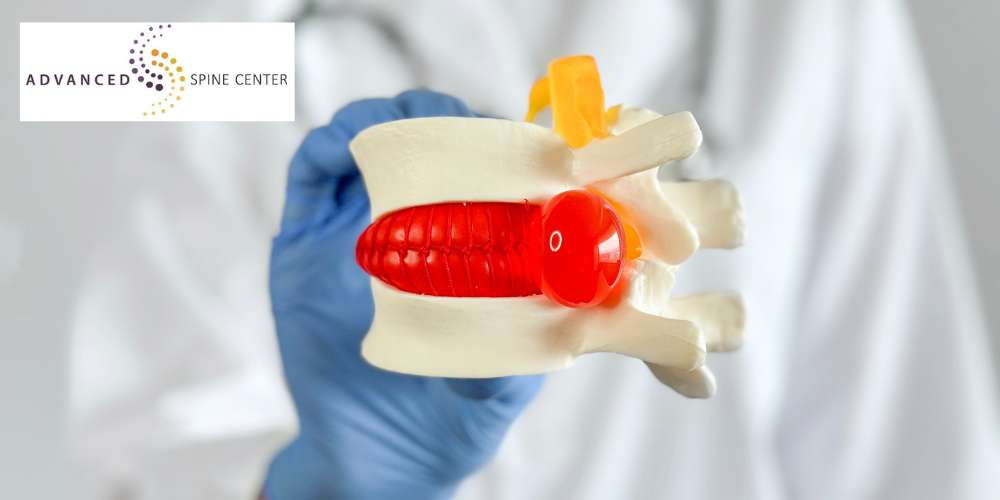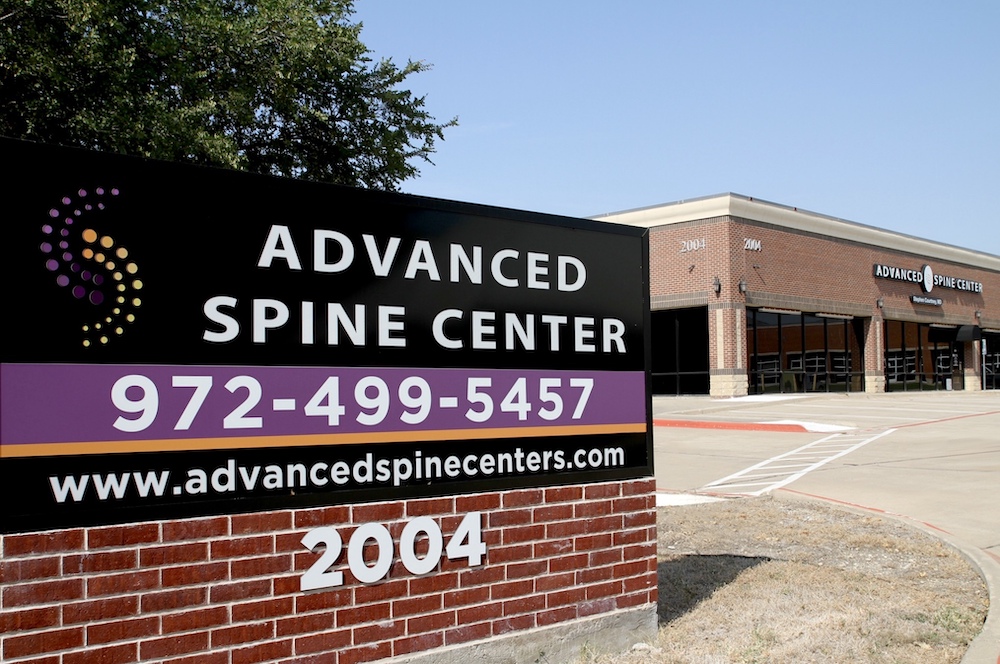Lumbar Revision Surgery in McKinney, TX
Home > Orthopedic Spine Surgeon McKinney, TX > Lumbar Revision Surgery in McKinney, TX
Specialties

At the Advanced Spine Center, we prioritize patient-centric care and advanced orthopedic spine surgeries, including lumbar revision surgery. Our commitment lies in delivering exceptional care by utilizing cutting-edge techniques and tailored approaches to address complex spinal conditions like spinal stenosis and chronic pain. If you are a McKinney, TX resident with a failed lumbar spine surgery, we have solutions for you.
To schedule an appointment with us, please call our office at 972-499-5457 or fill out the online intake form by clicking the button below.
What Is Lumbar Revision Spine Surgery?
Lumbar revision surgery is a specialized surgical procedure aimed at correcting complications or failures that arise from a previous spine surgery performed in the lumbar region. It involves a comprehensive reevaluation and potential correction of problems related to the spinal hardware, vertebrae, or surrounding tissues that might have persisted or emerged after the initial surgery.
During lumbar revision, surgeons employ advanced techniques to address issues such as inadequate healing, recurrent pain, or limited mobility resulting from previous surgeries. The ultimate goal is to enhance functionality, reduce discomfort, and improve the patient’s quality of life.
When Do Surgeons Recommend Lumbar Revision?
Surgeons might consider recommending lumbar revision surgery when patients experience persistent or worsening symptoms after the initial surgery. Common indications for lumbar revision surgery include:
- Persistent Pain: Despite the initial surgery, patients continue to experience unresolved or recurring pain that affects their daily activities and quality of life.
- Failed Fusion: Failed spinal fusion surgery leading to inadequate fusion between spinal bones, causing instability, pain, spinal deformity, or discomfort.
- Recurrent Disc Herniation: Development of a new herniation in the spinal disc after a previous discectomy.
- Hardware Complications: Issues such as implant migration, breakage, or infection affecting the integrity of the spinal hardware.
- Progressive Neurological Symptoms: Such as weakness, numbness, or tingling that persist or worsen post-surgery.
How Common Is Lumbar Revision?
Lumbar revision surgery is much less common than primary spinal surgeries. The need for lumbar revision depends on various factors, including the nature of the initial spinal procedure, patient-specific conditions, and the surgical techniques employed. While exact statistics may vary, the demand for revision surgeries is often a result of the complexity of spinal issues and the need for specialized care.
In general, failed spine surgery is uncommon, but still a possibility in any initial spine surgery. Most patients experience significant relief from their symptoms and positive outcomes following their spinal surgeries.
What Are the Different Types of Lumbar Revision Surgery?
Lumbar revision surgery encompasses various approaches and techniques tailored to address specific issues. Examples of different types of revision spine surgeries include the following.
Re-exploration Surgery:
This involves revisiting the site of the initial surgery to identify and address issues such as scar tissue formation, incomplete fusion, or hardware-related problems. Surgeons meticulously evaluate the previous surgical area to ensure comprehensive correction.
Decompression Surgery:
When nerve compression persists or recurs, surgeons might perform decompression procedures to alleviate pressure on affected nerves, thereby relieving associated symptoms like pain or numbness.
Extension of Fusion:
In cases where instability or degeneration affects adjacent levels of the spine, surgeons might extend the fusion to those areas to provide added stability and support.
Anterior/Posterior Spinal Fusion:
It is also possible for the surgeon performing the revision to take a different approach than what was used for the initial surgery. For example, maybe the first surgery was performed using an anterior approach (from the front of the spine). In the revision surgery, the surgeon may opt for a posterior approach (from the back of the spine) to get a better look at the issue.
Failed Lumbar Fusion Revision Surgery
Failed fusion, a significant concern after spinal fusion, can lead to persistent pain and spinal instability. Revision surgery aims to address these issues by meticulously addressing factors contributing to fusion failure. This may involve the removal of existing hardware, revision of fusion techniques, and stabilizing the affected spinal segments.
Failed Back Surgery Syndrome (FBSS)
FBSS is a term used to describe persistent pain and symptoms following one or more spinal surgeries. It encompasses various symptoms, including pain at the surgery site, radiating pain in the legs or back, and reduced functionality. Patients experiencing FBSS often seek specialized care to manage and potentially address their persistent symptoms.
What Are Common Reasons That Lumbar Spine Surgeries Fail?

Several factors contribute to the failure of lumbar spinal fusion surgeries, which may include the following.
- Inadequate Fusion: Fusion failure leading to instability and persistent pain.
- Recurrent Disc Herniation: Development of a new herniation in the spinal disc post-surgery.
- Hardware Issues: Problems with implants or instrumentation affecting spinal stability.
- Scar Tissue Formation: Excessive scar tissue causing nerve compression and associated symptoms.
- Degeneration of Adjacent Levels: New issues arising in nearby spinal segments due to degeneration or wear.
How Do Surgeons Fix a Failed Back Surgery?
Addressing a failed back surgery requires a meticulous and personalized approach. Surgeons may utilize a combination of minimally invasive techniques to address specific issues.
- Hardware Removal or Replacement: Correcting issues related to spinal implants or hardware causing complications.
- Revision Fusion Techniques: Enhancing fusion procedures to improve stability and promote successful fusion between spinal bones.
- Decompression Procedures: Relieving pressure on nerves to alleviate symptoms associated with nerve compression.
- Stabilization Techniques: Employing methods to stabilize and support affected spinal segments, reducing instability and associated symptoms.
How Can Patients Prepare for Lumbar Revision Surgery?
Preparation for lumbar revision surgery involves several steps, such as the following.
- Consultation and Evaluation: Patients undergo a comprehensive discussion with the surgeon, providing detailed information about their medical history, previous surgeries, symptoms, and expectations from the revision surgery. They may also undergo certain imaging tests, such as X-rays or MRIs (magnetic resonance imaging).
- Medical Clearance: Ensuring overall health and readiness for surgery through various medical evaluations and tests.
- Understanding the Procedure: Gaining thorough knowledge about the surgery, potential outcomes, and realistic expectations post-surgery.
- Preoperative Instructions: Following specific guidelines provided by the surgical team, including instructions related to fasting, medications, and lifestyle changes before surgery.
What to Expect During Your Lumbar Revision
During lumbar revision surgery, your surgeon will use the information they gathered before surgery to craft a treatment plan for your specific situation. While each procedure is unique to the patient being treated, you can expect the following general steps.
Anesthesia: Patients are administered either general or regional anesthesia based on the surgical approach and patient preferences. This ensures comfort and pain management during the procedure.
Incisions and Access: Surgeons access the spinal canal through the previous incisions or create new ones, depending on the nature of the revision surgery. The surgical team meticulously follows surgical plans to reach the target area while minimizing tissue disruption.
Surgical Procedure: Specific techniques and approaches are employed by the surgical team to address the issues identified during preoperative evaluations. In many cases, a bone graft is necessary as part of the treatment. Our providers work meticulously to achieve optimal correction while ensuring patient safety.
Lastly, the surgeon will close the incision and ensure the patient remains comfortable post-surgery.
What Is Recovery Like After Lumbar Revision Spinal Surgery?
Postoperative recovery following lumbar revision involves several key aspects, often including the following.
- Hospital Stay: The duration of hospitalization may vary based on the complexity of the surgery and individual patient progress. During this time, medical professionals closely monitor patients to ensure optimal recovery and manage any postoperative issues.
- Pain Management: Patients receive medications and pain management strategies to alleviate discomfort and manage pain during the recovery phase.
- Physical Therapy and Rehabilitation: Rehabilitation and physical therapy play a crucial role in the recovery process. A tailored rehabilitation program helps in restoring strength, flexibility, and mobility while reducing the risk of complications.
- Activity Restrictions: Patients are given specific instructions regarding activities to avoid and limitations during the initial recovery period to promote healing and prevent complications.
How Long Does Recovery Last After Lumbar Revision?
The duration of recovery following lumbar revision surgery varies among individuals and depends on various factors, including the following.
- Extent of Surgery: The complexity and extent of the revision procedure significantly impact the recovery timeline.
- Overall Health: Patients in good health tend to recover faster and more effectively.
- Adherence to Rehabilitation: Commitment to postoperative rehabilitation and physical therapy programs greatly influences the speed and success of recovery.
- Body’s Healing Response: Every individual’s body heals at its own pace, affecting the overall duration of recovery.
In general, patients may experience varying recovery times, ranging from several weeks to months, before achieving maximal recovery and returning to normal activities.
What Factors Make a Good Candidate for Lumbar Revision Spine Surgery?
Suitable candidates for lumbar revision surgery typically exhibit the following characteristics:
- Persistent Symptoms: Patients experiencing persistent symptoms following initial lumbar surgery despite conservative treatments.
- Overall Health: Individuals in good overall health without significant comorbidities that might complicate surgery or recovery.
- Realistic Expectations: Having realistic expectations about the outcomes of revision surgery and being informed about potential risks and limitations.
- Willingness for Rehabilitation: Being committed to participating in postoperative rehabilitation and adhering to recommended guidelines for a successful recovery.
Possible Complications and Risks of Lumbar Revision Spinal Surgery
While uncommon, lumbar revision surgery carries potential risks and complications, including:
- Infection: The risk of developing a surgical site infection, which may require additional treatment and management.
- Nerve Damage: The possibility of nerve damage during the surgery, which may lead to new or worsened symptoms.
- Failed Fusion: The fusion might not achieve the desired results, leading to ongoing instability and persistent symptoms.
- Persistent Pain: Continued or new-onset pain post-surgery, which might necessitate further evaluation and management.
Call the Advanced Spine Center for Revision Lumbar Spine Surgery in McKinney, TX
At the Advanced Spine Center, our team of highly skilled and experienced spine surgeons is dedicated to providing comprehensive care for patients seeking lumbar revision surgery. If you are experiencing persistent symptoms or complications following a previous lumbar surgery, we encourage you to reach out to us for a personalized consultation. Our team will work closely with you to develop a tailored treatment plan, leveraging advanced techniques and personalized care to help you regain function and improve your quality of life.
To schedule an appointment with us, please call our office at 972-499-5457 today or fill out our online intake form.

Request an Appointment
Common Patient Questions
ExcellentBased on 147 reviews
 Robert AliceaThe doctor and his staff were very welcoming and kind ..explained my issues in detail . Will highly recommend
Robert AliceaThe doctor and his staff were very welcoming and kind ..explained my issues in detail . Will highly recommend German CisnerosEvery visit to Dr. Courtney's office is educational and most beneficial. Dr. Courtney and ALL of his staff are the best!
German CisnerosEvery visit to Dr. Courtney's office is educational and most beneficial. Dr. Courtney and ALL of his staff are the best! Jamey DerryberryMy wife and I both go to Dr Courtney for back issues. Great care. Great staff. Great surgical facility and smooth process. LOVE THEM!!!
Jamey DerryberryMy wife and I both go to Dr Courtney for back issues. Great care. Great staff. Great surgical facility and smooth process. LOVE THEM!!! Mark CotterDr Courtney and his staff truly care about my well being. They are the only ones I have found that have been able to help me with my workman's comp claim
Mark CotterDr Courtney and his staff truly care about my well being. They are the only ones I have found that have been able to help me with my workman's comp claim J “JAFO”Does your back hurt? Has your back been hurting, yet no other surgeon can or won't help you; or worse tells you nothing is wrong? You're in the wrong place! I had 4 back operations with no improvement. I had an additional 6 other consultations with "there's nothing wrong with you". The truth was I was probably 2-3 months away from permanent leg and lower back paralysis. He fixed me. I can stand, I can walk. I threw away my crutches of 13 years. If you need back correction - GO SEE THIS DOCTOR! He will fix you, and fix you correctly, if it is humanly possible. Enough said! Go see him. He tells the truth and tells it like it is. 🙂
J “JAFO”Does your back hurt? Has your back been hurting, yet no other surgeon can or won't help you; or worse tells you nothing is wrong? You're in the wrong place! I had 4 back operations with no improvement. I had an additional 6 other consultations with "there's nothing wrong with you". The truth was I was probably 2-3 months away from permanent leg and lower back paralysis. He fixed me. I can stand, I can walk. I threw away my crutches of 13 years. If you need back correction - GO SEE THIS DOCTOR! He will fix you, and fix you correctly, if it is humanly possible. Enough said! Go see him. He tells the truth and tells it like it is. 🙂 Terri StewmanDr courtney and his staff are great! Dr courtney always takes his time with you and I feel he truly cares about his patients.
Terri StewmanDr courtney and his staff are great! Dr courtney always takes his time with you and I feel he truly cares about his patients. Ross WigingtonGreat Dr and helped me multiple times over the years Would recommend to anyone that needs help
Ross WigingtonGreat Dr and helped me multiple times over the years Would recommend to anyone that needs help Bridgette e MentesanaDr. Courtney is knowledgeable and takes the time to really explain what’s going on and explain why you’re in pain and the several options to correct the issue. I never felt rushed and he was on time to our appointment which is such a rare thing. The rest of the office staff was absolutely top notch. They were really down to earth and so nice, you could tell they liked their jobs and were treated well. It was a very welcoming atmosphere. I felt very comfortable and I knew I was in capable hands just by the way he treated his staff and listened to his patients. Highly recommend.
Bridgette e MentesanaDr. Courtney is knowledgeable and takes the time to really explain what’s going on and explain why you’re in pain and the several options to correct the issue. I never felt rushed and he was on time to our appointment which is such a rare thing. The rest of the office staff was absolutely top notch. They were really down to earth and so nice, you could tell they liked their jobs and were treated well. It was a very welcoming atmosphere. I felt very comfortable and I knew I was in capable hands just by the way he treated his staff and listened to his patients. Highly recommend. Marie BentonDr Courtney did my neck surgery and my 360 back surgery. I would not go to another surgeon, he cares about his patients and it shows! His staff is great as well! I trust his opinion and skills 100%
Marie BentonDr Courtney did my neck surgery and my 360 back surgery. I would not go to another surgeon, he cares about his patients and it shows! His staff is great as well! I trust his opinion and skills 100%

